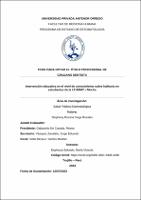Intervención educativa en el nivel de conocimiento sobre halitosis en estudiantes de la I.E 80047 – Moche
Abstract
Intervención educativa en el nivel de conocimiento sobre halitosis en estudiantes de la I.E 80047– Moche. Trujillo.
Material y Método: El diseño de estudio fue experimental y longitudinal, se realizó en estudiantes de la Institución Educativa 80047-Moche de manera virtual, evaluando a 122 estudiantes de 1er y 2do año de secundaria. Además, se empleó un cuestionario de 20 ítems el cual fue validado a través de juicio de expertos según la prueba V de Aiken= 0.978 y con una confiabilidad de alfa de Cronbach de 0.777. Para el análisis de los resultados se utilizó la prueba no paramétrica Friedman y la prueba de Wilcoxon para la comparación de grupos.
Resultados: Los resultados mostraron que la intervención educativa fue eficaz, debido que antes de la intervención educativa el nivel de conocimiento fue ineficiente con un 86.9%, inmediatamente después de la intervención el nivel de conocimiento fue suficiente de 49% y al mes de la intervención el nivel de conocimiento sobre halitosis aumentó a bueno con el 92.6%. Además, se encontró que existe diferencia significancia entre cada momento evaluado antes, inmediatamente después y al mes, presentando un incremento en el nivel de conocimiento
Conclusiones: La intervención educativa fue eficaz sobre el conocimiento de halitosis en os estudiantes del nivel secundario de la I.E 80047- Moche. Educational intervention of the level of knowledge about halitosis in students of the I.E 80047- Moche.
Material and Method: The study design was experimental and longitudinal, it was carried out in secondary level students of the Educational Institution 80047-Moche in a virtual way, evaluating 122 students of 1st and 2nd year of high school. In addition, a 20-item questionnaire was used, which was validated through expert judgment according to Aiken's V test = 0.978 and with a reliability according to Cronbach's alpha test with a coefficient of 0.777. For the analysis of the results, the non-parametric Friedman test and the Wilcoxon test were used to compare the groups.
Results: The results showed that the educational intervention was effective, because before the intervention the level of knowledge was bad with 86.9%, immediately after the intervention the level of knowledge increased to a regular value of 49% and at month after the intervention, the level of knowledge about halitosis increased to good with 92.6%. In addition, it was found that there is a significant difference between each moment evaluated (before, immediately after and a month), presenting an increase in the level of knowledge over time.
Conclusions: The educational intervention was effective on the level of knowledge in halitosis for the students of the secondary level of the I.E 80047-Moche
Subject
Collections
- Estomatología [653]


